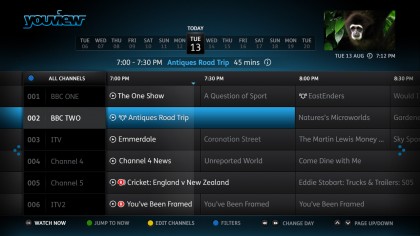Inside YouView: pushing the demand for on-demand TV
TechRadar speaks to YouView about television in the UK

It's been nearly 18 months since the launch of YouView in the UK and in this time the perception of IPTV (internet protocol television) has changed significantly. The number of people receiving television through a broadband connection has gone from minority to mainstream: the audience has caught up with catch up.
In the UK, YouView has had a significant part to play in this. Recent stats show that the service - which is backed by major ISPs including BT and TalkTalk - gets 2.7 million VOD requests a week, proving that while linear TV may still make up 90% of views, there is an increasing demand for on-demand, especially through an actual television set.
For YouView, the trick to getting users to watch TV through an internet connection is to treat these IP-based shows and channels as you would traditional terrestrial television. It believes that whether a show is piped through a broadband cable or an aerial it shouldn't really make any difference.
"The user doesn't care where the channels come from and that is the absolute ambition for YouView: that they don't know where the content is coming from," explained Susie Buckridge, Director of Product at YouView, to TechRadar.
"At the moment we provide three little blue dots as a pointer, which go grey if you aren't connected to the internet, so we do have nods but overall seamless TV is key."
Premium features
This idea of "seamless TV" is at the heart of YouView. It's a service that was created to bring balance to a television market in the UK which was becoming increasingly dominated by Pay TV behemoths - namely Virgin and Sky.
"The user doesn't care where the channels come from"
Sign up for breaking news, reviews, opinion, top tech deals, and more.
YouView set out to offer on-demand features embedded into its set-top boxes that were a step up from what Freeview or Freesat were providing.
Understandably, before launch, the pay TV crowd were concerned with the idea of YouView offering features that rivaled their own – such as a backwards EPG, supercharged search and IP channels. 18 months on, though, things have changed so much that Sky is now offering its non-contract service, Now TV, through YouView's platform.
However, for those working at YouView, it was the logistics of bringing together a consistent package of broadband-based TV and traditional television that was the real challenge, rather than fending off sniping from the opposition.

"Right back from when YouView was launched when we were designing how the system would work, the interface, we knew that we would be looking at channels from other sources - not just digital terrestrial," explained Piers Lomax, Head of Engineering at YouView, to TechRadar.
"The foundations for IP channels was in there from day one. But it's not obvious to people viewing these channels that a lot of the technology involved is very different from traditional broadcast."
According to Lomax, simplifying things for the user actually requires a lot of complex work behind the scenes.
"When dealing with IP channels, you don't have the concept of a tuner like you do with a TV device, you need the internet connection and a multicast system, which both BT and TalkTalk are using right now. And that requires some software to manage which takes time to get right."
Cutting your losses
One of the biggest things for Lomax was making sure that when someone sits down to watch an on-demand show coming from the internet the experience was on a par with what comes through an aerial.
"It is all about making sure the picture quality is reliable," noted Lomax. "We have to be tolerant of any kind of losses of packets, we have to be able to recover this information in the same way digital terrestrial software can recover from some signal loss. But it is very different from the digital channel world."

Marc Chacksfield is the Editor In Chief, Shortlist.com at DC Thomson. He started out life as a movie writer for numerous (now defunct) magazines and soon found himself online - editing a gaggle of gadget sites, including TechRadar, Digital Camera World and Tom's Guide UK. At Shortlist you'll find him mostly writing about movies and tech, so no change there then.